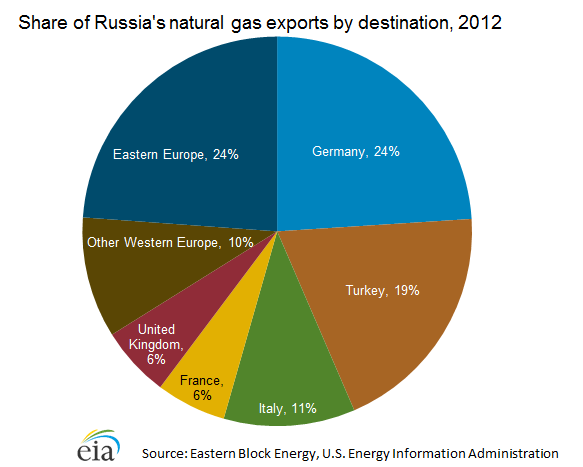The US Energy Information Agency (EIA) website has a lot of detailed data on Russian fossil fuels and energy usage. I am only going to mention those relevant to reserves and exports of oil and natural gas, and energy usage.
Oil and natural gas earns Russia 70% of its $515 billion in exports. They also supply 52% of Russia’s federal budget.
Europe gets 25% of its natural gas from Russia.
Russia has the largest natural gas reserves in the world.
Europe’s sources of natural gas are shown below, from The Lithuania Post of July 19, 2013
Russia has the largest natural gas reserves in the world. The leading countries in reserves are shown in the bar graph below. The units are in trillion cubic feet.
The US figure in the chart below is only for “wet gas” which means that it also contains liquids ethane and butane, which makes it more valuable.
Since other articles here use cubic meters of gas, we have to note that 1 cubic meter equals 35.314 cubic feet. The US also uses BTUs, where 1 cubic foot equals 1,027 BTU. Our gas bills are also in therms, which is 100,000 BTU, and therefore approximately 100 cubic feet.
In liquid fuels, Russia is the third largest producer, at 10.4 million barrels per day (bbl/day). For scale, world oil production is about 89 million bbl/day. US oil usage has declined from about 19 million bbl/day to 16 million bbl/day. Russia distributes this oil through its Transneft pipeline network. Russia exports about 7.2 million bbl/day.
Russian electricity production is 220 GigaWatts of electricity. It is building 10 nuclear reactors. Its energy comes 56% from natural gas, 19% petroleum, coal only 14%, and renewables and others 10%.
According to the NY Times, 53% of European gas imports from Russia go through Ukraine. (Earlier versions of the NY Times said 80% or 63%, which may be the source of other figures circulating on the internet. This also can be time dependent, since Europe had a warmer winter and used less gas.) The pipelines through Ukraine serve Germany, Italy, and France.



